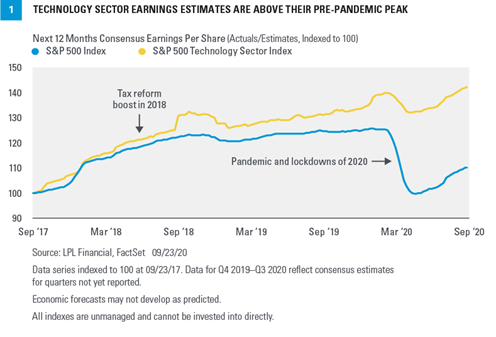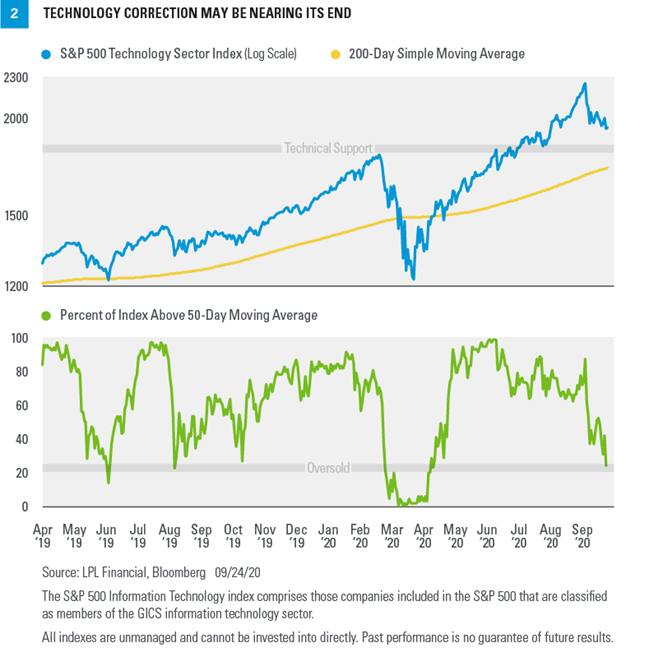What Does The Technology Correction Mean For The Market?
By Jeffrey Buchbinder
The recent correction in the S&P 500 Index’s technology sector presents a unique challenge to markets following a historic stretch of outperformance as technology’s share of the market has ballooned in size.
Despite September weakness in this sector that has dragged the broader market lower, we expect technology leadership to continue given supportive underlying fundamental and technical conditions.
A September To Remember
During the COVID-19 pandemic, technology has played a curious role in mitigating downside during bouts of volatility, while also posting considerable outperformance when markets rebounded, as many viewed the sector as relatively well insulated from the economic effects of the virus.
After a “melt-up” environment for tech during the month of August, the sector so far has corrected more than 12% from its prior high in September, a historically weak month for the S&P 500. Investors are asking if the weakness will continue.
Fundamentals Are Supportive
The question of whether technology’s strong performance since March has put it in bubble territory has received a lot of attention in the financial media as well as with investors. Although we acknowledge that some of the better-performing technology and technology-related stocks have been on an upward trajectory similar to that of the late 1990s until the recent sell-off, we don’t believe technology is in a bubble.
We would first point out how strong fundamentals are right now. Earnings estimates for the sector have already moved above their pre-pandemic highs. While there is risk that these expectations may not be achieved, the gap between technology sector earnings and earnings from the entire S&P 500—which includes technology—is impressive [Figure 1].
During the second quarter of 2020, technology was one of only three sectors to produce earnings growth—along with healthcare and utilities—in a quarter in which S&P 500 earnings fell 32% year over year. For 2020, consensus estimates are calling for 5% earnings growth for the sector, which would be the best among all 11 S&P 500 sectors (source: FactSet).
We believe these earnings justify the sector’s premium valuation. The technology sector is trading at a price-to-earnings (PE) ratio of about 24 times estimated 2021 earnings, which is roughly 22% above the broader S&P 500. With interest rates so low and earnings growth scarce, we believe this valuation is reasonable in absolute and relative terms. Historically, 20% premiums to the market’s PE have been typical for technology.
We understand the argument that the tailwinds the sector has enjoyed during the pandemic may fade, potentially limiting the sector’s growth opportunities from here. In a year, we may not be setting up as many home offices or buying so many devices for kids to learn remotely. If this causes earnings momentum in the sector to fade, technology stocks could be used as a source of funds to move into cyclical value stocks that have lagged.
Nevertheless, while some of the trends driving the sector, such as cloud computing and e-commerce, may slow down once the pandemic is over, some of these behavioral changes may become structural and may not reverse.
We acknowledge that investing in the sector right now carries risks. In addition to the potential for the economic recovery to stall because of COVID-19, US-China tensions ratcheting higher and disrupting supply chains may present the biggest risk to the sector. Regulatory risk around antitrust and privacy concerns may be another potential consideration.
Tech Correction Could Be Buyable
The S&P 500 Technology Sector Index has pulled back nearly 13% from its September 2 close through its closing low point as of September 25, putting the sector firmly in correction territory.
However, from a technical analysis perspective, we believe that this correction was overdue and driven primarily by how stretched prices had become rather than due to internal deterioration or the beginning of a long-term rotation out of the sector. In fact, following an 11.8% gain in August and an 80% rally from the March lows, the sector was trading more than 31% above its 200-day moving average as of September 2, the most since April 2000.
Pullbacks in uptrends have historically represented opportunities, and this may be the case with the technology sector. Technology has represented the most consistent area of relative strength for the S&P 500, not just year to date, but for the past decade, and the recent decline does little to change that long-term picture.
Data shows that we may be getting close to oversold conditions based on the percent of stocks in the sector trading above their 50-day moving average [Figure 2]. Historically, when that reading has moved as low as 20–25%, as it did multiple times during 2019, it has occurred close to a market bottom. That reading reached 23.6% the third week of September, meaning more than three out of four companies in the sector had broken below their trend lines.
Finally, the technology sector has substantial technical support at the February highs, and the rising 200-day moving average that currently sits just below that level. There is precedent for the sector stabilizing after retracing a move back to its 200-day moving average after being so far above it, but because the moving average calculation is rapidly rising, that support level may meet or exceed the February highs by the time prices move back to that level.
Conclusion
We certainly understand investors’ angst when previous outperformers correct, which some believe may be a precursor to a much worse environment for equities. However, we maintain our preference for the technology sector based on solid fundamentals and a still-bullish technical picture.
While some rotation into other cyclical sectors may be a reassuring sign that markets are pricing in an end to the pandemic, we would view recent technology weakness as a buying opportunity and expect the sector to maintain leadership in the next leg of this bull market.
Jeffrey Buchbinder is an equity strategist for LPL Financial






PR Can Help You Jump The Social Distancing Hurdles
Study Reveals Perceptions About Life Insurance Ownership Around World
Advisor News
- Athene Enhances Flagship Annuity Products, Expands Innovative Preset Allocation Feature
- Advisor gives students a lesson in financial reality
- NC Senate budget would set future tax cuts, cut state positions, raise teacher pay
- Americans believe they will need $1.26M to retire comfortably
- Digitize your estate plan for peace of mind
More Advisor NewsAnnuity News
- Athene Enhances Flagship Annuity Products, Expands Innovative Preset Allocation Feature
- GBU Life introduces Defined Benefit Annuity
- EXL named a Leader and a Star Performer in Everest Group's 2025 Life and Annuities Insurance BPS and TPA PEAK Matrix® Assessment
- Michal Wilson "Mike" Perrine
- Emerging digital annuity sales process cutting cycle times by 94%, IRI says
More Annuity NewsHealth/Employee Benefits News
- New lawsuit challenges state's Medicaid eligibility rules
- In defiant speech, Lawson-Remer calls for bigger county spending, unity against federal cuts
- Editorial | Why Medicaid funding crisis matters here
- Recent Findings in Liver Cancer Described by Researchers from Kaohsiung Chang Gung Memorial Hospital (Comparing Health Insurance-reimbursed Lenvatinib and Self-paid Atezolizumab Plus Bevacizumab In Patients With Unresectable Hepatocellular …): Oncology – Liver Cancer
- Missouri Farm Bureau wants to offer health insurance alternatives for members
More Health/Employee Benefits NewsLife Insurance News
- $184.2M financing secured for Seagis East Coast industrial portfolios
- AFBA and 5Star Life Insurance Company Name Erica L. Jenkins Senior Vice President, General Counsel, and Corporate Secretary
- Athene Enhances Flagship Annuity Products, Expands Innovative Preset Allocation Feature
- Empathy Collaboration with Voya Financial Brings Industry-First Legacy Planning to Millions
- Federated celebrates record year despite industry challenges at 121st annual meeting
More Life Insurance News